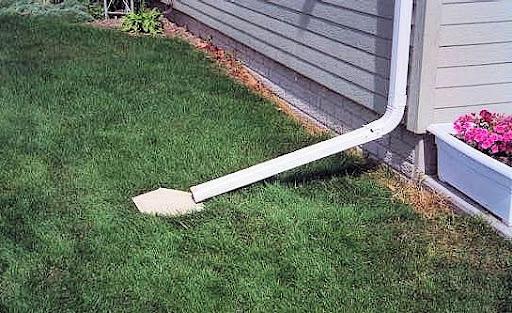Anne Arundel County Code §13-2-206 - Discharging water into roads
A person may not empty, discharge, or cause or allow to be emptied or discharged from premises occupied by the person, directly or indirectly, to or on any county road a liquid other than rainwater flowing in its natural course.
Sump Pumps
The sump pump is a mechanical device, normally located in the basement of a home, used to pump water from the basement sump pit area to outside the home. A sump pump is often used
in cases where the house’s basement is below the water table level, and in locations where flooding is common. Once the water in the sump pit reaches a certain level, the sump pump activates and pumps the groundwater through a discharge pipe. The roof downspout or basement sump discharge should spill onto a splash pad or through a flexible hose to a drainage area on your property. However, the flow should not be directed onto an adjacent property or County property.

Downspouts
A downspout is a pipe that runs vertically along the side of the home. It is connected at the top to a hole in the gutter channel. The other end bends outward and usually sits several inches above the ground. This allows the water to flow away from the home as it exits the pipe.

Prohibited Locations for Downspout and Sump Pump Discharges
It is illegal to discharge rainwater from downspouts or groundwater from the sump pump into the County sanitary sewer, storm drain system*, or road right-of-way. The County systems are not designed to carry the additional flows. In addition, downspout or sump pump discharges across sidewalks and into the roadway can create hazardous conditions.
Suggested Discharge Locations and Techniques
1. Relocate downspout or sump pump discharges: The downspout or sump discharge point may be relocated so that it discharges a minimum of ten feet from the property line adjacent to a street or sidewalk. This distance may enable the water to infiltrate and absorb into the ground before reaching the street or sidewalk. The downspout or sump pump discharge may also be relocated to the backyard or side yard of the property. Backyard and side yard discharges should be located a minimum of ten feet from the property line to allow the water to infiltrate and absorb into the ground before reaching the neighbor’s property.

2. French drains or discharge wells: Water may be dissipated by using underground perforated drains or rock filled wells that distribute and allow water to percolate into the surrounding soil. Size of pit and rock will depend on frequency and volume of discharge. The property owner may need to consult an engineer.

3. Rain gardens: Rain gardens are small depressed garden areas filled with moisture loving plants. Downspout or sump pump discharge may be directed to these areas to facilitate infiltration. Information on how to install a rain garden is available by contacting the Bureau of Watershed Protection.

4. Rain barrels: A rain barrel is a container that collects and stores discharged water for future watering of lawns and gardens. Generally, a rain barrel is made using a 55-gallon drum and piping connected to the downspout or sump pump discharge.

Disclaimer
The effectiveness of suggested discharge locations and techniques depends on unique site conditions, frequency and volume of downspout or sump pump discharge. Consultation with an experienced professional may be necessary.
